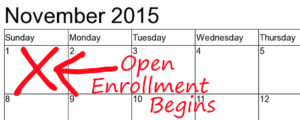 It’s been a busy day in the healthcare reform world. All in one day, CMS/HHS just fulfilled two of my wishes. In December, I wrote about why I thought open enrollment should extend into the new year (at the time, the proposed regulations called for a 2016 open enrollment period starting on October 1, 2015 and ending December 15, 2015).
It’s been a busy day in the healthcare reform world. All in one day, CMS/HHS just fulfilled two of my wishes. In December, I wrote about why I thought open enrollment should extend into the new year (at the time, the proposed regulations called for a 2016 open enrollment period starting on October 1, 2015 and ending December 15, 2015).
And then earlier this week, I wrote about how we need a special enrollment period for people who don’t file a tax return until after February 15, find out at that point that they owe a penalty for being uninsured in 2014, and are stuck with no choice but to also incur a penalty for 2015, since open enrollment would have already ended for the year.
Today, CMS announced a special enrollment period for people who didn’t know about the individual mandate penalty, and find out about it when they file their taxes. It runs from March 15 to April 30, and is valid for people in the 37 states that use Healthcare.gov for enrollment. Three other states (VT, MN, and WA) had already implemented similar special enrollment periods, and several other states are considering them. I’m optimistic that Connect for Health Colorado will follow suit, although they haven’t announced anything yet…. stay tuned!
2016 Open Enrollment Period Announced
Later in the day, HHS released the final Benefit and Payment Parameters for 2016. One of the issues that was finalized was the 2016 open enrollment period. It’s officially scheduled for November 1, 2015 through January 31, 2016. So it will still be three months, just like the 2015 open enrollment period (the proposed open enrollment period was supposed to be only 2.5 months long), and most importantly, it will extend into 2016 to allow people whose plans are auto-renewed to make a change after the start of the year. This was my reasoning for wanting open enrollment to continue into the new year, and HHS noted in the final regulations that this was one of the reasons they ultimately settled on an end date of January 31. The final regulations do note that the schedule will be re-evaluated for 2017, so it’s likely to change again before we settle in on a recurring annual schedule. But for now, we know what to expect next winter.


